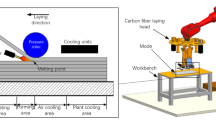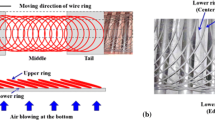Abstract
The self-resistance electrical (SRE) heating method to cure the carbon-fiber-reinforced polymer (CFRP) parts possesses the advantages of rapid and volumetric heating, low energy consumption, and low asset investment. But the current SRE heating methods are difficult to uniformly cure the shaped CFRP parts due to the non-uniformly distributed Joule heat power in the parts with a varying cross-sectional area. In this paper, an optimized multi-zone SRE heating method is proposed, in which the uniform heating and curing process of the shaped CFRP part is firstly achieved. By optimizing the orientation of the rectangular zones, the local overheating caused by the voltage gradient and current diffusion between different zones is notably suppressed. Combined with the electro-thermal numerical analysis, the influence of the positional offset of electrodes in two adjacent zones on the temperature uniformity is investigated. Based on this, an automated zone discretization algorithm and the optimal selection method of the zone orientation are established. The proposed method is numerically and experimentally validated with the typical-shaped CFRP parts, and the results are compared with that of the existing SRE heating method. The proposed method realizes that the maximum in-plane temperature difference of shaped CFRP parts is reduced by more than 80%. This method significantly improves the temperature uniformity of shaped CFRP parts during the multi-zone SRE heating process, which provides a potential solution for high-quality and efficient curing of CFRP parts.
















Similar content being viewed by others
Data availability
Not applicable for that section.
Code availability
Not applicable for that section.
References
Hamerton I, Mooring L (2012) The use of thermosets in aerospace applications. In: Thermosets. Elsevier 189–227
Soutis C (2005) Fibre reinforced composites in aircraft construction. Prog Aerosp Sci 41:143–151. https://doi.org/10.1016/j.paerosci.2005.02.004
Friedrich K, Almajid AA (2013) Manufacturing aspects of advanced polymer composites for automotive applications. Appl Compos Mater 20:107–128. https://doi.org/10.1007/s10443-012-9258-7
Mishnaevsky L, Branner K, Petersen H, Beauson J, McGugan M, Sørensen B (2017) Materials for wind turbine blades: an overview. Materials 10:1285. https://doi.org/10.3390/ma10111285
Tang DZ (2013) The application of carbon fiber materials in sports equipment. AMM 443:613–616. https://doi.org/10.4028/www.scientific.net/AMM.443.613
Maria M (2013) The faculty of operation and economics of transport the air transport department univerzitna, Advanced composite materials of the future in aerospace industry. INCAS BULLETIN 5:139–150. https://doi.org/10.13111/2066-8201.2013.5.3.14
Mujahid Y, Sallih N, Abdullah MZ, Mustapha M (2021) Effects of processing parameters for vacuum-bag-only method on void content and mechanical properties of laminated composites. Polym Compos 42:567–582. https://doi.org/10.1002/pc.25848
Liu W, Li L, Zhang S, Yang F, Wang RG (2017) Mechanical properties of carbon nanotube/carbon fiber reinforced thermoplastic polymer composite. Polym Compos 38:2001–2008. https://doi.org/10.1002/pc.23771
Abliz D, Duan Y, Steuernagel L et al (2013) Curing Methods for Advanced Polymer Composites - A Review. Polym Compos 21:9. https://doi.org/10.1177/096739111302100602
Zhou J, Li Y, Li N, Y, Liu ST, Cheng LB, Sui SC, Gao J, (2018) A multi-pattern compensation method to ensure even temperature in composite materials during microwave curing process. Compos Part A Appl Sci Manuf 107:10–20. https://doi.org/10.1016/j.compositesa.2017.12.017
Xu XH, Wang XQ, Wei R, Du SY (2016) Effect of microwave curing process on the flexural strength and interlaminar shear strength of carbon fiber/bismaleimide composites. Compos Sci Technol 123:10–16. https://doi.org/10.1016/j.compscitech.2015.11.030
Bayerl T, Duhovic M, Mitschang P, Bhattacharyya D (2014) The heating of polymer composites by electromagnetic induction– a review. 57:27–40. https://doi.org/10.1016/j.compositesa.2013.10.024
Riccio A, Russo A, Raimondo A, Cirillo P, Caraviello A (2018) A numerical/experimental study on the induction heating of adhesives for composite materials bonding. Mater Today Commun 15:203–213. https://doi.org/10.1016/j.mtcomm.2018.03.008
Liu S, Li Y, Xiao S, Wu T (2019) Self-resistive electrical heating for rapid repairing of carbon fiber reinforced composite parts. J Reinf Plast Comp 38:495–505. https://doi.org/10.1177/0731684419832793
Lackmann J, Konrad S, Lambers H G, Huschen U (2015) Heating device for conductive heating a sheet metal blank. US 2015/0282253 A1
Matsumoto S, Yamanishi K (2011) Energization heating method and energization heating device. US 8,866,046 B2
Machrowicz T (2007) Method and apparatus for the uniform resistance heating of articles. US 07714253 B2
Behrens BA, Hübner S (2014) Konductive Erwarmung von Formplatinen für das Pressharten, Tech. Rep. 400. Institut für Umformtechnik und Umformmaschinender Leibniz Universit¨at Hannover
Demazel N, Laurent H, Carin M, Co¨er J, Le Masson P, Favero J, Canivenc R, Graveleau S (2016) Simulations of joule effect heating in a bulge test. AIP Conf Proc 1769:060014. https://doi.org/10.1063/1.4963450
Hübner S (2015) Method for conductively heating sheet metal, electrode, and heating device therefore. EP 3259377 A1
Demazel N, Laurent H, Carin M, Le Masson P, Salmon-Legagneur H (2021) A direct resistance heating method for shaped blank. J Manuf Process 62:772–783. https://doi.org/10.1016/j.jmapro.2020.12.056
Zhang B, Li Y, Liu S et al (2021) Layered self-resistance electric heating to cure thick carbon fiber reinforced epoxy laminates. Polym Compos 42:2469–2483. https://doi.org/10.1002/pc.25992
Raoelison R, Fuentes A, Pouvreau C, Rogeon P, Carr´e P, Dechalotte F, (2014) Modeling and numerical simulation of the resistance spot welding of zinc coated steel sheets using rounded tip electrode: analysis of required conditions. Appl Math Modell 38(9–10):2505–2521. https://doi.org/10.1016/j.apm.2013.10.060
Zhao K, Wietbrock B, Hirt G (2011) Numerical and experimental analysis of electric conductive heating for micro warm coining of stainless steel. German Acad Soc Prod Eng 11. https://doi.org/10.1007/s11740-011-0345-7
Martins JMP, Alves JL, Neto DM (2016) Numerical analysis of different heating systems for warm sheet metal forming. Int J Adv Manuf Technol 83:897–909. https://doi.org/10.1007/s00170-015-7618-9
Athanasopoulos N, Kostopoulos V (2012) Resistive heating of multidirectional and unidirectional dry carbon fibre preforms. Compos Sci Technol 72:1273–1282. https://doi.org/10.1016/j.compscitech.2012.04.018
Liu S, Li Y, Shen Y, Lu Y (2019) Mechanical performance of carbon fiber/epoxy composites cured by self-resistance electric heating method. Int J Adv Manuf Technol 103:3479–3493. https://doi.org/10.1007/s00170-019-03707-0
Hassan MH, Othman AR, Kamaruddin S (2017) A review on the manufacturing defects of complex-shaped laminate in aircraft composite structures. Int J Adv Manuf Technol 91:4081–4094. https://doi.org/10.1007/s00170-017-0096-5
Taysom BS, Sorensen CD, Hedengren JD (2017) A comparison of model predictive control and PID temperature control in friction stir welding. J Manuf Process 232–241. https://doi.org/10.1016/j.jmapro.2017.07.015
Cominos P, Munro N (2002) PID controllers: recent tuning methods and design to specification. IEE Proceedings-Control Theory and Applications 149(1):46–53. https://doi.org/10.1049/ip-cta:20020103
Acknowledgements
The authors would like to acknowledge the team members, for their continuous support.
Funding
This work was supported by a major project of the National Natural Science Foundation of China (grant no. 52090052), National Natural Science Foundation of China (grant no. 51775261), and Postgraduate Research & Practice Innovation Program of Government of Jiangsu Province (KYCX18_0319); the authors sincerely appreciate the continuous support provided by our industrial collaborators.
Author information
Authors and Affiliations
Corresponding author
Ethics declarations
Ethics approval
Not applicable for that section.
Consent to participate
Not applicable for that section.
Consent for publication
Not applicable for that section.
Additional information
Publisher's Note
Springer Nature remains neutral with regard to jurisdictional claims in published maps and institutional affiliations.
Rights and permissions
About this article
Cite this article
Shen, Y., Lu, Y., Liu, S. et al. Self-resistance electric heating of shaped CFRP laminates: temperature distribution optimization and validation. Int J Adv Manuf Technol 121, 1755–1768 (2022). https://doi.org/10.1007/s00170-022-09153-9
Received:
Accepted:
Published:
Issue Date:
DOI: https://doi.org/10.1007/s00170-022-09153-9




